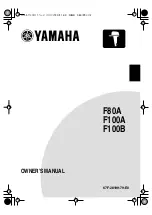
36
SHIFTING AND SPEED CONTROL
Shifting
To shift into “FORWARD”, squeeze the lock-out
lever on the control handle and move the con-
trol handle forward to approximate position
A
,
as shown in the illustration.
To shift into “REVERSE”, squeeze the lock-out
lever on the control handle and move the con-
trol handle rearward to approximate position
B
,
as shown in the illustration.
A detent or notch is present on all Suzuki con-
trol boxes to provide a “feel” for positions
A
,
B
,
and neutral. Always shift quickly and firmly from
neutral to position
A
or
B
to prevent abnormal
wear on the gear and clutch engagement sur-
faces.
NOTICE
Severe engine damage may occur if (a)
engine speed is not allowed to return to
idle and boat speed is not reduced when
shifting from “FORWARD” to “REVERSE”
or from “REVERSE” to “FORWARD”, or
(b) care is not taken when operating the
boat in reverse.
Always allow the engine speed to return
to idle before shifting. Exercise caution
and use minimal speed when operating
the boat in reverse. Be sure the handle/
shift lever is in the desired position
before accelerating.
NOTICE
If you shift gears when the engine is not
running, the shifting mechanism can be
damaged.
Avoid shifting gears when the engine is
not running.
NOTE:
Top mount type
Not equipped with a lock-out lever. Exercise
care when selecting neutral position.
Speed control
To increase speed after you have shifted into
gear, continue moving the control handle for-
ward or rearward.
WARNING
Since the same handle is used for shift-
ing and speed control it is possible to
move the handle past the detent and
engage the throttle. This can cause the
boat to move suddenly resulting in per-
sonal injury or property damage.
You must be careful not to move the con-
trol handle too far forward or rearward
when shifting.
NEUTRAL
32˚
32˚
FORWARD
REVERSE
Top mount
type
FORWARD
35˚
35˚
REVERSE
NEUTRAL
















































